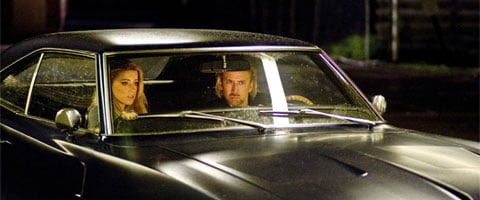To 3D Or Not To 3D: Choose The Right Drive Angry Ticket

By itself Patrick Lussier’s Drive Angry knows exactly what it’s supposed to be: a schlocky, gun and explosion filled to road movies from the ‘60s and ‘70s. While we’ve seen efforts similar to this in recent years, the most notable being Robert Rodriguez and Quentin Tarantino’s Grindhouse, this film brings a new element to the table: 3D. But like with all 3D movies we must ask is it worth the extra $4?
Breaking it down part by part, below you will find a full analysis of Drive Angry’s use of the 3D technology and discover whether or not an adventure into the third dimension is worth it. Check it out!

Does It Fit?
As long as they keep making 3D movies, the debate will continue: can live action films compete with animated/heavy-CGI films in the third dimension. But while that question may never be answered, one thing is for certain: action movies work with 3D. Thanks to explosions with plenty of shrapnel are haphazard gun fire, there’s never a shortage of items that can be thrown at the audience. This isn’t a concept that’s lost on director Patrick Lussier who knows exactly what kind of movie he’s making and caters scenes particularly for the new medium. Going even further, though most of the effects in the film are done practically, the CGI that is used is almost exclusively to support the 3D effect. His formula of guns, explosions, fast cars and visual flair plus an added dimension is hard to argue with.
3D Fit: 5/5

Planning & Effort
Indulge me for a moment and take a quick peek at the poster for Drive Angry 3D. While it isn’t new for movies to advertise themselves as three dimensional affairs, this movie takes it to another level, making sure that the audience knows that this one was actually “shot in 3D” (a detail that the director told me he personally had the marketing team include). So what does this mean? Drive Angry 3D is a movie that, from its inception was planned for stereoscope. Every little bit of staging, framing and angling is done with 3D in mind to reward those that shelled out the extra $4 for the experience. There are movies that have treated 3D like an afterthought, and then there are movies like Drive Angry.
Effort: 5/5

Beyond The Window
Your Daily Blend of Entertainment News
There are exactly two ways that 3D can help the movie-going experience. First is by establishing depth, turning the flat screen into a window that lets the audience look into a bigger world. The other is the ability to have things on the screen feel like they are coming right at you to the point that you feel like something is eventually going to land in your lap. I will address the latter in the next section, but first we deal with the former. Though it really shouldn’t be a surprise after reading everything above, Drive Angry does a phenomenal job of creating depth. The viewer is constantly looking down long stretches of highway as Nicolas Cage and Amber Heard make their way across the country and get in to chase after chase, and you always feel completely immersed. There’s not a single point in the film where the screen feels like a wall separating the audience from the action, which only makes the experience more fun.
Beyond The Window: 5/5

Before The Window
As effective as Drive Angry may be at drawing you into its world, that experience is no match for the other side of the coin: the stuff that they throw at you. Typically considered the “gimmicky” side of 3D, the director previously used this effect brilliantly for the horror film My Bloody Valentine 3D, where the killer would constantly throw stuff towards the camera and it would feel like it’s coming right at you. This tradition continues in his newest film. Whether Nicolas Cage is firing off a round from the ultra-cool God Killer gun or William Fichtner is throwing a coin high in the air, the audience is constantly shifting back in their chairs as objects leap off the screen and reach for the 20th row. This category alone is worth the price of admission alone, and even if every other category you read about here got a zero I would probably still recommend it.
Before The Window: 5/5

Brightness
Remember that stupid song “Sunglasses at Night” by Corey Hart? “Who the hell would be dumb enough to wear shaded glasses in the dark?” everyone asked. Well, if you’ve been to a 3D movie, apparently you are that dumb. One of the greatest challenges facing 3D still is that every scene is made dimmer by the audience’s head gear. As a result, directors have to compensate by introducing more light so that people can actually see what’s going on. Luckily most of Drive Angry’s action happens during the day or in well lit rooms, but when the sun sets and characters are still outside, it does present a problem. One scene in particular towards the end makes you want to leave the theater and somehow develop un-tinted 3D glasses. Drive Angry has incredible use of the technology in most areas, but brightness remains an issue.
Brightness: 3/5

Audience Health
Now we come to what is probably the most subjective of categories. There are people out there that can’t watch 5 minutes of 3D without getting a headache or nausea, while others can watch six hours of 3D footage without feeling even slightly uncomfortable. There are a couple factors at play here, but the biggest bully when it comes to audience health and the third dimension and that’s not knowing where to focus your eyes. Fortunately, with the exception of one shot that comes very early in the film, Drive Angry 3D won’t give you any problems and you should be able to walk out of the theater feeling like a spring chicken. It’s also worth noting that I’m a prescription eyeglass wearer, meaning I’m one of those dumb-looking assholes who watches 3D movies with two pairs of glasses on his face. While this has affected my movie watching experience previously, it didn’t in the case of this film.
Audience Health: 4/5

The Glasses Off Test
If there’s one universally despised aspect of the 3D experience, it’s having to wear those chunky, plastic glasses that don’t seem to fit anybody correctly. But until glasses-less technology is perfected – we are still many, many years away – we will have to wear them. Why? Because without them the screen is a blurry, unwatchable mess. By that same token, however, the extent of that blurry, unwatchable mess is a great indication of depth of field. Simply put, the blurrier the screen, the more powerful the 3D. In that respect, Drive Angry 3D is a home-run. Taking off your glasses you can barely recognize shapes let alone characters or objects. Even better, this applies not only to the action-packed sequences, but the dialogue scenes as well. Every little pixel of Drive Angry is made for 3D.
Glasses Off Test: 5/5
| SCORES RECAP | |
| 3D Fit | 5 |
| Planning and Effort | 5 |
| Beyond The Window | 5 |
| Before The Window | 5 |
| Brightness | 3 |
| Audience Health | 4 |
| The Glasses Off Test | 5 |
| Total Score | 32 (out of a possible 35) |
Final Verdict: As the title implies, Drive Angry 3D is a movie that is meant to be seen in third dimension. The incredible amount of work put in by director Patrick Lussier and his crew is quite noticeable and actually increases the pleasure that comes with watching the film. As technology gets better and better and filmmakers learn how to properly use it, the 3D experience is guaranteed to improve over time and this is a fine example. As I mentioned above, the debate rages on whether live-action will ever be able to compete with animation and CGI-heavy films in the arena and while we’re probably still far away from the definitive answer, Drive Angry 3D is an argument that it can.
This poll is no longer available.
For more 3D analysis, visit our To 3D Or Not To 3D archive right here.

Eric Eisenberg is the Assistant Managing Editor at CinemaBlend. After graduating Boston University and earning a bachelor’s degree in journalism, he took a part-time job as a staff writer for CinemaBlend, and after six months was offered the opportunity to move to Los Angeles and take on a newly created West Coast Editor position. Over a decade later, he's continuing to advance his interests and expertise. In addition to conducting filmmaker interviews and contributing to the news and feature content of the site, Eric also oversees the Movie Reviews section, writes the the weekend box office report (published Sundays), and is the site's resident Stephen King expert. He has two King-related columns.
